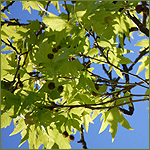Forest fires and straw and stubble burning in North America and Eastern Europe are leading to record-high concentrations of the environmental toxin PCB over the Arctic island of Svalbard, a report warns.
 Over the past decades, persistent organic pollutants (POPs) have been found in large concentrations in Arctic areas.
Over the past decades, persistent organic pollutants (POPs) have been found in large concentrations in Arctic areas.
These substances accumulate in living organisms and are enriched throughout the food chain.
Polychlorinated biphenyl (PCB) is one of the most important environmental toxins of this type.
“We wanted to draw attention to the causes of the environmental impact in the Arctic and trace the sources of the problem,” said Sabine Eckhardt, a researcher at the Norwegian Institute for Air Research (NILU).
When biomass from trees and dead grass and leaves catches fire, it releases both PCB and other environmental toxins and creates yet another source of PCB emissions.
In 2004 and 2006, big fires ravaged these areas. About 5.8m hectares of coniferous forest burned down in North America, while Eastern Europe experienced extensive emissions from agriculture due to straw and stubble burning.
Several weeks later, the researchers found record-high values of PCB in the atmosphere above Svalbard.
“As far as we know, this is the first study that shows a connection between the burning of biomass and PCB concentrations in the atmosphere far away,” said Sabine Eckhardt.
“With a climate that is constantly changing, we expect the extent of such fires to increase.
“In such case, it also means that the fires may represent an increasing environmental problem in the Arctic.
“That in turn will reduce the effect of the international agreements that aim to reduce emissions of these environmental toxins,’ said Ms Eckhardt.
PCB is a group of synthetically-produced persistent toxic compounds., and can be stored in the fatty parts of the organism and accumulates in the food chain.
Humans, fatty fish and carnivores (such as polar bears) can therefore accumulate concentrations in their bodies that are so high that they are poisoned.
As the primary emissions of organic environmental toxins are reduced, the researchers believe that fires caused by climate change will become more important.
They point to the fact that there has been little focus on the significance of burning biomass, and the potential consequences of this for the Arctic environment.
“For the first time, we have proved that burning biomass is also an important source of persistent organic pollutants in polar areas,” Ms Eckhardt observed.
“This can be of great importance to international agreements that aim to protect the environment in Arctic areas.”
Source: The Research Council of Norway
Date: 31/05/2010
Filed under: biodiversity, carbon, climate change, forest fires, research | Tagged: agriculture, arctic, biology, climate change, forest fires, pollution, slash and burn, svalbard | 1 Comment »





